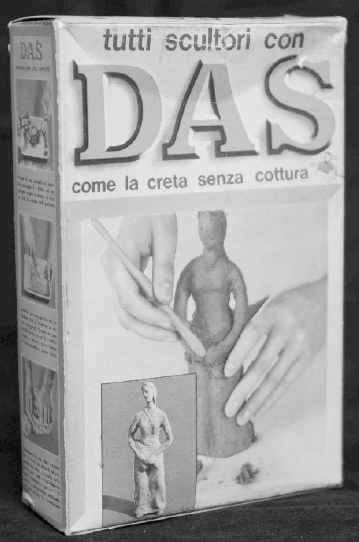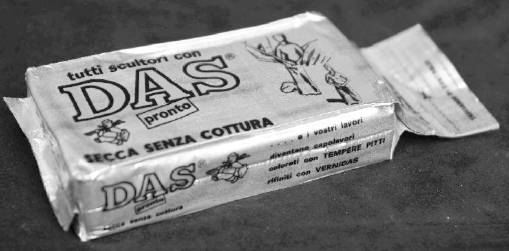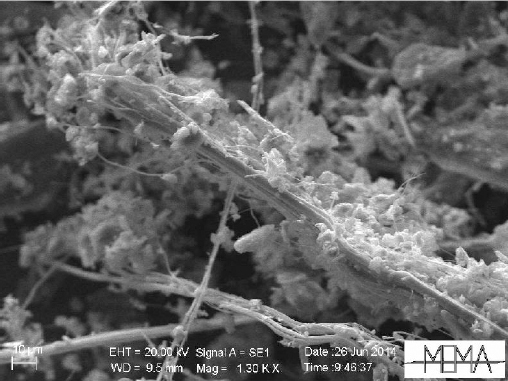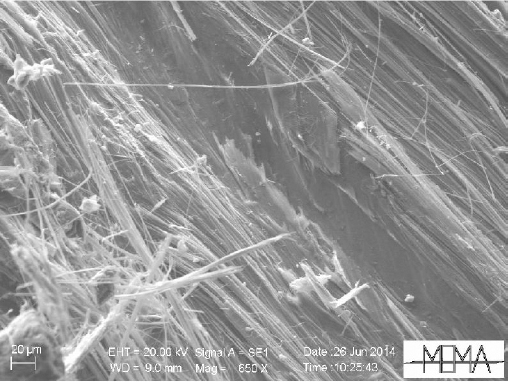In public health, children should be given the most attention as they are the future of our society. They should not suffer the consequences of exposure to pollutants during the most delicate phase of their life cycle. Prevention of exposure to hazardous agents should include attention to substances that may be present in toys (1). For 30 years, regulatory measures on this issue have been focused on both materials and the way to use them. The first piece of legislation was issued in Italy in 1983 (2). This was followed by other acts, including a European Directive No 378 in 1988 (3). Several studies have addressed the issue of safety in places of recreation (4–6). Only some of these studies have detected opportunities for exposure to asbestos in childhood (7–9).
The present paper describes the use of asbestos in DAS (named for its inventor Dario Sala), an artificial clay that was widely used as a toy and teaching material in Italy and some European countries during the 1960s and part of the 1970s. DAS could be molded into various shapes and styles, and, unlike traditional clay, did not require baking to harden. Air drying makes the paste solid and stable with a hardness similar to that of conventional clays requiring treatment at high temperature. In addition to its use as a toy, DAS was used in art laboratories and in conservation and refurbishment of pottery. A restorer of archeological pottery first reported the presence of asbestos in DAS to our laboratory and provided us with an original box of the material (figure 1). DAS was produced and sold in powder and, later, as a wet ready-to-use paste (figure 2).
For the purpose of this work, the presence of a significant quantity of asbestos was confirmed through qualitative polarized optical and scanning electron microscopy (SEM). We integrated this observation with original administrative documents confirming the use of asbestos in DAS formula until 1975 and the quantities annually purchased. Finally, interviews with past employees were conducted, as they were the sole remaining source of information, in order to estimate the quantity of annual production and identify the most relevant suppliers and purchasers of the product.
Methods
In order to describe in detail the history and composition of the mineral that characterizes this toy, statements were obtained from former past employees of the manufacturer: namely, the chief technician of the chemical laboratory and three administrative staff (two belonging to the export department and a third to the purchasing department).
Purchase orders and sale invoices relative to DAS production were searched at the State Archive of Turin, where the original corporate documents of the seller are officially deposited and indexed.
In addition to the original DAS sample from the archeological restorer, a paste sample being sold as a vintage toy was obtained from the internet. Both forms were analyzed and, subsequently, the laboratory chief technician certified the period in which these items were produced.
An original specimen of the ore of the Balangero asbestos mine (located in Northern Italy near the city of Turin) was used for the purpose of comparison.
The powder sample was first analyzed by optical microscope with polarized light using the technique of chromatic dispersion using Cargille liquids at different refraction index (10). The same method was used to analyze the paste and both samples were compared with a National Institute for Occupational Safety and Health (NIOSH) reference mineral chrysotile (CH-29), Mg3Si2O5(OH)4 (11).
Subsequently, the two samples were analyzed from a qualitative point of view, by SEM and x-ray energy dispersive (EDX) microanalysis, at the University of Florence’s Department of Earth Sciences. The Balangero sample underwent the same SEM characterization (12). Aliquots of the materials under investigation (powdered and paste samples, Balangero ore specimen) were placed on stubs using double-sided conductive adhesive tape and subsequently coated by graphite. Secondary electron micrographs were obtained using a SEM Zeiss EVO MA15, by applying a potential of 20 kv to the electron beam. Punctual and raster micro-analytical investigations were carried out using the Oxford INCA 250 microanalysis operating on the same SEM instrument. Operating under these experimental conditions, the uncertainty of the microanalysis of the major elements (the content of which is >5 wt%) can be estimated in 2 relative % using a pure Co standard.
The estimated level of exposure during the manufacture of the product in similar operations involving loose asbestos fibers (13) was obtained for comparison.
Results
Historical reconstruction of DAS production
The firm Adica Pongo, which produced DAS, closed in 1993. The information on DAS preparation and formula was obtained through statements released by the chief laboratory technician formerly employed by Adica Pongo. According to this source, Mr Dario Sala (1912–2005), an eclectic person with inventive, creative, artistic and literary talent invented this product in Milan, Italy, in 1962. He obtained a patent for his creation that he called DAS, after his initials. He then ceded the patent for a pittance to a company, Adica Pongo, specialized in supplying school equipment, located in the province of Florence, Italy, which then began large-scale production of the toy. From 1962 to about 1965, DAS was produced and marketed, also as a toy for children, in powder contained in a cardboard box weighing 500 grams. In order to be used, the powder had to be mixed with a certain amount of water until obtaining a smooth paste. The dough could be molded for about three hours after preparation at room temperature. This was followed by complete drying and hardening at room temperature for about 24 hours. In the mid 1960s, the physical state of the product changed from dust to wet paste, vacuum-packed in robust plastic film bags, in packs of 500 g and 1 kg, eliminating the need for addition of water for molding. The composition of this artificial clay consisted of about 30 wt% talc, Mg3(OH)2Si4O10, 30 wt% gypsum, CaSO4×2(H2O) and 30 wt% asbestos fiber, the remainder being a sort of glue, still covered by patent. The mineral fibers added to the product had the purpose of improving ductility and malleability as well as reinforcing the structure. Intentional addition of asbestos fibers in clay has been already described. Nobody knows whether Mr. Dario Sala took his idea from the ancient Finnish habit to add asbestos fibers already 4000 years ago (14–15). Later, the percentage composition was changed and asbestos fiber content was reduced to about 25 wt%. Both the statements and the traced purchase orders and sale invoices involving the asbestos mine (Amiantifera di Balangero, Turin, Italy) as the sole supplier of raw asbestos, indicate that the use of this mineral in the product lasted throughout 1975 and early 1976. From then until now, asbestos in DAS has been replaced with cellulose. Amiantifera di Balangero has been the biggest asbestos producer by quantity in Western Europe (16). The original bills of sale and purchase, issued respectively by the seller and the manufacturer and preserved by the State Archive in Turin, were recovered: 17 bills refer to the purchase of about 30 tons each for a total amount of 510 tons of asbestos. In previous years, an annual average of about 800 tons of asbestos were purchased in order to annually produce about 2650 tons of DAS.
DAS was initially sold only in the Italian market but after 1970, Adica Pongo organized an Export Department dedicated to trade with foreign countries. The main foreign purchaser of DAS was located in Netherlands. Other importers were in Germany, UK, and Norway. In compliance with the increasing awareness of the risks caused by asbestos exposure, the British purchaser questioned the presence of asbestos in the product. Indeed, in 1974 the correspondence letters, still preserved in the Turin State Archive, offer proof of the growing concern of the company about the danger of asbestos. In fact the General Management of Adica Pongo wrote to the company Amiantifera of Balangero asking about the possible presence of amphibole in their asbestos. Amiantifera replied on 5 July 1974, stating that “our asbestos is made up of pure chrysotile” and that “medical studies have shown that when asbestos is combined with other substances, such as in your case, it is deprived of the possibility to produce dust, thus excluding the risk of inhalation”. On 8 July 1974, Adica Pongo required Amiantifera to produce the medical studies and a written statement that their asbestos was totally amphibole free. Amiantifera refused to produce further qualitative analysis and suggested the company refer to “the University of Florence for any qualitative determination of the asbestos fibers”. Nevertheless, according to the purchase invoices, 510 tons of raw asbestos were still used during the whole of 1975 for the production of DAS, and Amiantifera of Balangero still reserved 500 tons for the manufacturer but, according to documents, no more asbestos was purchased. Adica Pongo continued producing asbestos-free DAS until its closure in 1993. Another company took over the asbestos-free DAS formula in 1995, and is currently still producing it.
Analyses of the material under investigation
The secondary electron micrographs of the DAS powder sample investigated are shown in figure 3, showing the presence of fibers, grouped in bundles and elongated. The bending of the fibers suggests the presence of chrysotile, Mg3Si2O5(OH)4. In the micrographs, obtained on both paste and powder DAS fragments, aggregates with predominant lamellar morphology consist of gypsum and talc. Findings with SEM show no substantial differences between powdered and paste DAS with regard to the presence and type of fibers. Figure 4 shows the morphological characteristics of the Balangero chrysotile ore sample used as reference. Well curved fibers, peculiar characteristic of chrysotile, can be observed.
Table 1 shows the results of EDX micro-analytical analysis, which verified the correctness of the attribution of the fiber fraction in the DAS to chrysotile asbestos.
Table 1
EDX microanalysis (averages more points of analysis) of the samples investigated. Results are expressed in wt%. Theoretical chrysotile chemical composition is shown, for comparison.
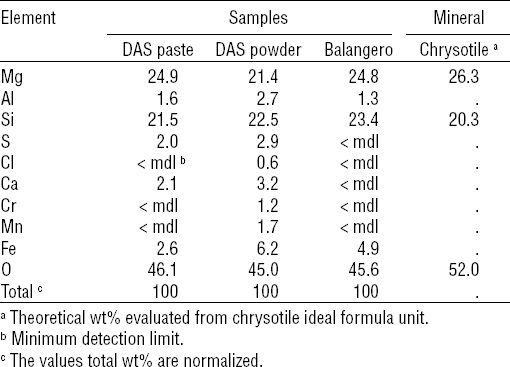
The micro-analytical results show a close similarity of the composition of the DAS samples with the chrysotile composition. Moreover, the average analyses of the two samples (powdered and paste DAS) are in good agreement with the analysis of the Balangero chrysotile. This result confirms the identification of fibers as chrysotile in the two samples of DAS. As far as the presence of minor elements is concerned, the two cases, toy and Balangero chrysotile, need to be discussed separately. Calcium (Ca) and sulfur (S) can be attributed to the presence of a certain amount of gypsum in the individual analytical points. Indeed, the dimensions in the excitation volume produced by the electron gun in the sample can involve not only the fibers but also grains or crystals of the other species, especially in this material, so intimately intermixed. Similarly, the occasional finding of cromium (Cr), manganese (Mn) and chlorine (Cl) may derive from the species attached to the fibers. On the contrary, aluminium (Al) and iron (Fe) can occur as minor elements in chrysotile (17–18). Thus, Al and Fe can be considered a good basis for the attribution of the origin of the fiber. In this case, the micro-analytical content of these two elements agrees with the minor element composition of the fibers from Balangero, thus confirming purchase orders and sale invoices found at the State Archive in Turin.
Discussion
The results of the present study allowed us to determine without any doubt that asbestos was routinely used for DAS production during the 1960s and mid 1970s. During this period, several million packs were sold, mainly in Italy but also in other European countries. Asbestos consisted exclusively of chrysotile fibers, as detected by laboratory tests, provided during the relevant period by the Balangero mine. This product resulted in a peculiar source of exposure, containing up to 25–30% by weight of asbestos. This value is more than twice that of asbestos-cement (around 13 wt%).
This may have led to exposure to asbestos of several categories of persons. These include, in the first place, workers involved in the production of DAS, given that the raw material was used as loose fibers transported in paper bags directly from the Balangero mine. Initially, the bags were manually unloaded from trucks and stored in the warehouse. Bags were then manually emptied directly into the mixer while the talc and the gypsum came through pneumatic line. The mixer had a weak air exhaust to prevent the aspiration of the raw materials and high levels of dust were produced during the emptying and the shaking of the bag. The product packaging in boxes was semi manual. Two workers were involved in this task for each of the two packaging lines. Dust monitoring was never performed, consequently no measured data are available. However an air contamination up to tens of fibers/cc might be estimated during the worst conditions. Lower levels of exposure may be considered also for workers doing different tasks but operating in the same workshop. On the basis of this assumption, we can estimate a maximum of 15 workers who were indirectly exposed.
Environmental contamination was slightly improved when the product was transformed into paste, although the first part of the production process remained the same until the use of asbestos was discontinued. For DAS users, such as teachers, school children, artists, archaeologists etc, an important exposure to airborne fibers could have occurred during the manipulation of the DAS powder before the addition of water. The introduction of DAS paste eliminated the risk of asbestos exposure during paste preparation but not finishing of the product. Once hardened, the items were finished with either a chisel or abrasive paper, as suggested by the instructions on the box, which surprisingly did not mention the risk of exposure. This finding leads to several considerations:
-
For at least four years, DAS was produced and marketed as a powder;
-
The high percentage by weight of asbestos in the product is unparalleled in products mainly intended as toys;
-
The fact that children were an important target for the use of DAS is particularly disturbing, given their vulnerability to environmental hazards;
-
The total amount of asbestos used, in 13 years of production, was around 10 000 out of the 35 000 tons of product. The number of DAS powder and paste packs sold is estimated to be about 6 and 48 million, respectively. The number of end users is difficult to determine, but it may have been in an order of magnitude of some millions;
-
Although distribution was mainly in Italy, the product was certainly exported to the Netherlands, Germany, the UK, and Norway;
-
In 1962, when DAS was invented and marketed, the hazards of asbestos were already clear and widely reported in the scientific world (19–29). Obviously, this fact was not known to the inventor and (probably) the producer of DAS, at least until 1974 when the British importer pointed out the problem.
DAS was most used in molding. The molded items appear as a compact material and, thus, not able to easily release fibers into the atmosphere, unless they are mechanically disturbed with sanding or similar operations. Crafts made from asbestos-containing DAS do not constitute any risk to people or the surrounding environment as long as they are not crushed or powdered. The exposure levels can only be estimated as they have not been monitored. This has led to questioning whether such exposure might have caused damage to the health of DAS users. The presence of chrysotile in DAS was reported to the Italian mesothelioma epidemiological surveillance network, but it has never been the subject of scientific publication. Some previous reports of asbestos exposure among teachers and school children referred only to the presence of asbestos in the environmental setting (30–31). Therefore, when interviewed nowadays, mesothelioma patients, and particularly current and former teachers, are questioned about the past use of DAS. When reported, the manipulation of DAS powder – and in particular the finishing of items molded with DAS in the 1960s and 1970s – is interpreted as “certain exposure” to asbestos.
The findings reported in the present paper suggest that enquiries about the use of DAS should also be made to mesothelioma patients in European countries other than Italy.
From an epidemiological point of view, it will only be possible to measure the impact of this finding on the health of past users in a few years, when further information about the use of DAS will be collected from mesothelioma cases where occupational, environmental or familial past exposures have not been tracked. A limited presence of asbestos in toys has seldom been reported in the press, and this issue has never been published in scientific journals, so apparently this work is, to date, the only one to report asbestos exposure as a consequence of the use of teaching materials during school time.
In conclusion, these findings show that DAS resulted in a source of exposure to asbestos during the 1960s and mid 1970s for both production workers and users including children, as the product was advertised and sold also as a toy. This discovery shows the incompleteness of records on asbestos uses and suggests to test items, including toys, imported from countries where asbestos is not forbidden.


